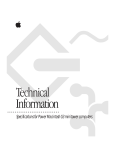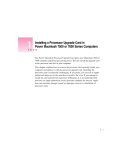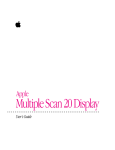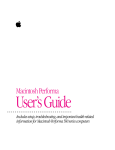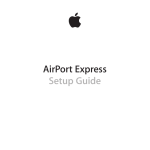Download Apple Ethernet CS Twisted-Pair Card User`s guide
Transcript
K Apple Ethernet CS Twisted-Pair Card User’s Guide FCC statement DOC statement This equipment has been tested and found to comply with the limits for a Class A digital device pursuant to Part 15 of the Federal Communications Commission (FCC) rules. These limits are designed to provide reasonable protection against such interference when the equipment is operated in a commercial environment. This equipment generates, uses, and can radiate radio-frequency energy and, if not installed and used in accordance with the instructions in this manual, may cause interference to radio communications. Operation of this equipment in a residential area is likely to cause interference, in which case the user, at the user’s own expense, will be required to correct the interference. DOC Class A Compliance This digital apparatus does not exceed the Class A limits for radio noise emissions from digital apparatus set out in the radio interference regulations of the Canadian Department of Communications. IMPORTANT Changes or modifications to this product are not authorized by Apple Computer, Inc., and could void the FCC certification and negate your authority to operate the product. This product was tested for FCC compliance under conditions that included the use of shielded cables and connectors between system components. It is important that you use shielded cables and connectors to reduce the possibility of causing interference to radios, television sets, and other electronic devices. For Apple peripheral devices, you can obtain the proper shielded cables through an Appleauthorized dealer. For non-Apple peripheral devices, contact the manufacturer or dealer for assistance. Observation des normes—Classe A Le présent appareil numérique n’émet pas de bruits radioélectriques dépassant les limites applicables aux appareils numériques de la Classe A prescrites dans les règlements sur le brouillage radioélectrique édictés par le Ministère des Communications du Canada. VCCI statement This manual is copyrighted by Apple or by Apple’s suppliers, with all rights reserved. Under the copyright laws, this manual may not be copied, in whole or in part, without the written consent of Apple Computer, Inc. This exception does not allow copies to be made for others, whether or not sold, but all of the material purchased may be sold, given, or lent to another person. Under the law, copying includes translating into another language. Contents The Apple logo is a registered trademark of Apple Computer, Inc. Use of the “keyboard” Apple logo (Option-Shift-K) for commercial purposes without the prior written consent of Apple may constitute trademark infringement and unfair competition in violation of federal and state laws. Installing EtherTalk software / 5 Every effort has been made to ensure that the information in this manual is accurate. Apple is not responsible for printing or clerical errors. © Apple Computer, Inc., 1994 20525 Mariani Avenue Cupertino, CA 95014-6299 (408) 996-1010 Apple, the Apple logo, AppleTalk, EtherTalk, LocalTalk, and Macintosh are trademarks of Apple Computer, Inc., registered in the United States and other countries. Simultaneously published in the United States and Canada. Mention of third-party products is for informational purposes only and constitutes neither an endorsement nor a recommendation. Apple assumes no responsibility with regard to the performance or use of these products. About this communications card / 2 What’s in the box / 2 Installing and connecting your card / 3 Setting the Network control panel for EtherTalk / 7 Changing your AppleTalk zone / 8 Disconnecting and moving your computer / 8 Troubleshooting / 9 Specifications / 11 For more information / 11 About this communications card The Apple Ethernet CS Twisted-Pair Card expands the communications capabilities of models of Macintosh computers that have a communications slot (CS). The card is designed for an Ethernet network that uses IEEE 10BASE-T standard twisted-pair cable. To connect to an Ethernet network, you must also install EtherTalk software, which is included with the Twisted-Pair Card. After you’ve added the card and installed EtherTalk software, you connect to your network by attaching a network cable to the card’s RJ-45 port and to a network controller unit (hub). The Apple Ethernet CS Twisted-Pair Card works only with Macintosh System 7 or later. For best performance your system should have at least 4 megabytes (MB) of random-access memory. 2 What’s in the box ■ ■ ■ ■ One Apple Ethernet CS Twisted-Pair Card Note: Keep the card inside its antistatic bag in the protective cardboard box until you’re ready to install it. One floppy disk containing EtherTalk software Warranty card User’s guide Note: You’ll need to obtain twisted-pair network cable separately. WARNING To avoid damage to the card and to your other computer equipment, be sure that you’ve turned off power to the computer before beginning installation procedures. 2. Remove the card from its antistatic bag. Installing and connecting your card 1. Follow the specific setup information that came with your Macintosh to open the back panel or lid, and locate the communications slot inside the computer. The material that comes with your Macintosh includes instructions to help you avoid damage to your computer’s components when installing the card. Be sure you’ve shut down and turned off the power to your computer before starting the installation. RJ-45 port Handle the card by its edges and avoid touching the components and connector as much as possible. 3. Align the card over the communications slot and press down firmly and evenly on both ends until the card fits snugly into place. You can test to see if the card is properly connected by lifting the card slightly. If it resists and stays in place, it’s connected. Handle the card by its edge. Push down evenly and firmly. To locate the communications slot for your computer, see the setup instructions that came with your Macintosh. 3 4. Follow the directions that came with your computer and replace the back panel or lid, and reattach any cables you removed earlier. Card’s green LED lights up when there’s a good network connection. Depending on the model you have, you will need to slide the logic board back into place, remove the communications port cover, replace a back panel, replace a lid, and so forth. 5. Plug the twisted-pair cable from your network into the RJ-45 port on your card. Just as with a telephone wire connector, you’ll hear a “click” when you plug in the cable. Other end of cable connects to network controller (hub). RJ-45 connector clicks when you attach it to the port. 6. Turn on the computer’s power switch, start up the computer, and check that the card’s green light-emitting diode (LED) is on. The card’s green LED lights up to indicate that there’s a good connection to the network. Note: Some early versions of the Apple Ethernet CS Twisted-Pair Card do not have an LED. If you have one of these cards, disregard all references to the LED in this guide. 4 Installing EtherTalk software To install the correct version of EtherTalk software you need to use the Installer program on the Network Software Installer disk, version 1.4.2 or later, included with your card. For safety, make sure that the Installer disk is locked before you use it. To lock a disk, slide the tab on the back side so that the square hole is open. Open the disk to find the Installer. Save the Installer disk after installation in case your startup disk gets damaged and you need to reinstall EtherTalk software. To install EtherTalk software: 1. Insert the Network Software Installer disk in your Macintosh and double-click the disk’s icon to open it. The Apple Ethernet CS Twisted-Pair Card requires the versions of software supplied on the Network Software Installer disk, version 1.4.2 or later. 5 2. Open the Installer program, review the Welcome screen, and click OK. 3. Make sure that the disk indicated on the Installer’s dialog box is your current startup disk, and click Install. 4. When you see a message reporting that the installation was successful, click Restart. Before you can use services on an Ethernet network, you need to select the EtherTalk network connection for your startup disk. The next section shows how. If you see a message indicating that the software cannot be installed while other programs are running, click Continue. If the correct startup disk is indicated, click to begin the installation. Name of the disk on which the software will be installed If another disk is currently selected, click this button until the name of your current startup disk appears. 6 Setting the Network control panel for EtherTalk A Macintosh computer’s network connection is preset for LocalTalk. To connect to an Ethernet network instead, you need to change the setting in the Network control panel. Follow these steps: 1. Choose Control Panels from the Apple () menu. 3. Click the EtherTalk connection to select it. A message asks you to confirm the change of network connections. You may have more network connection choices than those shown in the following figure. Click the EtherTalk connection. 2. Open the Network control panel. Shows available zones You need these versions or later. You set your network connection in the Network control panel. 4. Click OK to confirm the change of networks. 7 5. If you see the following dialog box, click OK. If you don’t see a dialog box, skip to step 6. 6. Close the Network control panel. You are now ready to use services available on your Ethernet network. IMPORTANT You may notice that the green LED on your card flashes occasionally. This is normal. It indicates that the computer is sending information over the network. Changing your AppleTalk zone If your network has been set up to allow you to choose a zone but you have not yet done so, the dialog box lists choices, with your designated zone selected. The zone you select determines the default location for any network services provided by your computer and listed in the Chooser (such as file sharing). Before you select a zone different than the one already highlighted, consult your network administrator. If you need to change zones in the future, just follow the steps described in the previous section. Remember, when you click the EtherTalk icon in the Network control panel, you see the list of available zones from which to choose. Disconnecting and moving your computer To disconnect your computer from the network, shut down your system and unplug the cable from the RJ-45 port on the card. If you plan to move your computer and reconnect to the network at a new location, notify your network administrator before you move. 8 Troubleshooting The first step in troubleshooting any problem with your network connection is to check that the card’s green LED light is on—if your card has an LED. When the computer sends information over the network, the LED flashes. If your card does not have an LED, you can’t use the LED in troubleshooting, but you can follow all the other guidelines for handling common problems. If the following suggestions don’t help you fix the problem, contact your network administrator. If the card’s green LED light isn’t on: Check each of the following items. ■ The computer’s power is on. ■ The card is installed correctly. ■ The network cable is attached to the RJ-45 port (and the controller unit) correctly. ■ The network cable is in good condition. ■ The controller unit (hub) that the cable is attached to is working. ■ Your Ethernet network is working properly—no one else is having problems with the network. If the card’s green LED light is on but you still have trouble with your network connection: Check that the controller unit (hub) for your cable is working properly—inspect it visually. Also check that your network cable is OK (try replacing it). Finally, confirm that your network is working properly. If you still have the problem, continue with the following guidelines. If the Network control panel icon is missing: The Network control panel may have been moved from the Control Panels folder. Look for it on your hard disk, drag it to the Control Panels folder, then restart your Macintosh. Your EtherTalk software may not have been installed properly. If you can’t find the Network control panel, you’ll need to reinstall the network software according to the instructions in this guide. If the EtherTalk icon doesn’t appear in the Network control panel: There may have been a problem with the network software installation. Reinstall your network software according to the instructions in this guide. 9 If you can’t select EtherTalk in the Network control panel: Be sure that the network cable is properly attached and that the card’s green LED is on. If you are still unable to select EtherTalk, there may have been a problem with the network software installation. Reinstall your network software according to the instructions in this guide. If you don’t see network services listed in the Chooser: Make sure your network connection is okay. Open the Network control panel and click EtherTalk. (If the Chooser is open, close and reopen it.) If you can access some services but can’t access a particular service (printing, for example), the device providing that service might be located in a different AppleTalk zone, or it might be malfunctioning, switched off, or disconnected from the network. There may also be a break somewhere in the network cables between your Macintosh and the missing service. 10 If your system can’t load EtherTalk at startup and reverts to LocalTalk: Your System file may be damaged or your EtherTalk installation was unsuccessful. Try reinstalling the network software. If the system won’t let you change the network connection: You may be using essential services (such as file sharing) or applications that might prohibit the change. Quit the service named in the system’s alert message and try switching the network connection again. You can also try quitting all application programs. If this doesn’t work, and it’s OK to disrupt services, shut down your Macintosh, using the Shut Down command. Restart the computer, change the network connection, and start the service or application again. If your card is defective or you have a problem with the installation and your network administrator cannot help: In the United States, contact the Apple Assistance Center at 800-SOS-APPL. In Canada call 1-800-263-3394. Outside the United States and Canada, contact your local Apple-authorized reseller. Specifications For more information Connector Ethernet 10BASE-T– compliant RJ-45 port The following books from Apple Computer, published by Addison-Wesley, are available at computer bookstores. Recommended cable Category 3, 26 gauge; 100 meters from card to hub, maximum Understanding Computer Networks gives an overview of networking basics. Ethernet transmit/receive data rate 10 megabits-per-second maximum Power dissipation Less than 1.5 watts, with an average of 1 watt Environmental requirements Operating temperature: 50˚ to 104˚ F (10˚ to 40˚ C) Humidity: 20% to 95% noncondensing Ethernet controller Planning and Managing AppleTalk Networks provides comprehensive information on setting up, maintaining, and troubleshooting small- to medium-sized AppleTalk networks. Inside AppleTalk, second edition, is the definitive technical guide to the protocol architecture of the AppleTalk network system. National Semiconductor DP83934 (SONIC-T) 11 030-5461-A

















